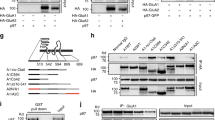Abstract
Long-term potentiation (LTP) of granule cell–Purkinje cell synapses in the mouse cerebellum requires phosphorylation by protein kinase A of the active-zone protein RIM1α at Ser413. Here, we show that the adapter protein 14-3-3 readily binds phosphorylated Ser413 in RIM1α, and that presynaptic transfection with a dominant-negative 14-3-3η mutant, or a RIM1α mutant with enhanced 14-3-3 binding, inhibits LTP. Thus, RIM1α phosphorylation triggers presynaptic LTP in part through recruitment of 14-3-3 to phospho-Ser413–RIM1α.



Similar content being viewed by others
References
Hansel, C., Linden, D.J. & D'Angelo, E. Nat. Neurosci. 4, 467–475 (2001).
Storm, D.R., Hansel, C., Hacker, B., Parent, A. & Linden, D.J. Neuron 20, 1199–1210 (1998).
Linden, D.J. & Ahn, S. J. Neurosci. 19, 10221–10227 (1999).
Castillo, P.E. et al. Nature 415, 327–330 (2002).
Lonart, G. et al. Cell 115, 49–60 (2003).
Aitken, A. et al. Biochem. Soc. Trans. 30, 351–360 (2002).
Berg, D., Holzmann, C. & Reiss O. Nat. Rev. Neurosci. 4, 752–762 (2003).
Watanabe, M. et al. Brain Res. Mol. Brain Res. 10, 151–158 (1991).
Thorson, J.A. et al. Mol. Cell. Biol. 18, 5229–5238 (1998).
Xing, H. et al. EMBO J. 19, 349–358 (2000).
Sun, L., Bittner, M.A. & Holz, R.W. J. Biol. Chem. 278, 38301–38309 (2003).
Castillo, P.E. et al. Nature 388, 590–593 (1997).
Roth, D. & Burgoyne, R.D. FEBS Lett. 374, 77–81 (1995).
Skoulakis, E.M. & Davis, R.L. Neuron 17, 931–944 (1996).
Broadie, K., Rushton, E., Skoulakis, E.M. & Davis, R.L. Neuron 19, 391–402 (1997).
Acknowledgements
We thank C. Howell, J. Mayer and S. Durkin for their help with the 14-3-3–RIM1α interaction studies and A.S. Shaw for providing 14-3-3η constructs. R. Bock provided technical assistance. Supported by an Eastern Virginia Medical School Bridge Grant, the Jeffress Memorial Trust (G.L.) and US Public Health Service MH51106 and the Develbiss Fund (D.J.L.).
Author information
Authors and Affiliations
Corresponding author
Ethics declarations
Competing interests
The authors declare no competing financial interests.
Supplementary information
Rights and permissions
About this article
Cite this article
Simsek-Duran, F., Linden, D. & Lonart, G. Adapter protein 14-3-3 is required for a presynaptic form of LTP in the cerebellum. Nat Neurosci 7, 1296–1298 (2004). https://doi.org/10.1038/nn1348
Received:
Accepted:
Published:
Issue Date:
DOI: https://doi.org/10.1038/nn1348
- Springer Nature America, Inc.
This article is cited by
-
Dysregulation of peripheral expression of the YWHA genes during conversion to psychosis
Scientific Reports (2020)
-
Changes in Brain 14-3-3 Proteins in Response to Insulin Resistance Induced by a High Palatable Diet
Molecular Neurobiology (2015)
-
Redundant functions of RIM1α and RIM2α in Ca2+-triggered neurotransmitter release
The EMBO Journal (2006)
-
Molecular organization of the presynaptic active zone
Cell and Tissue Research (2006)





